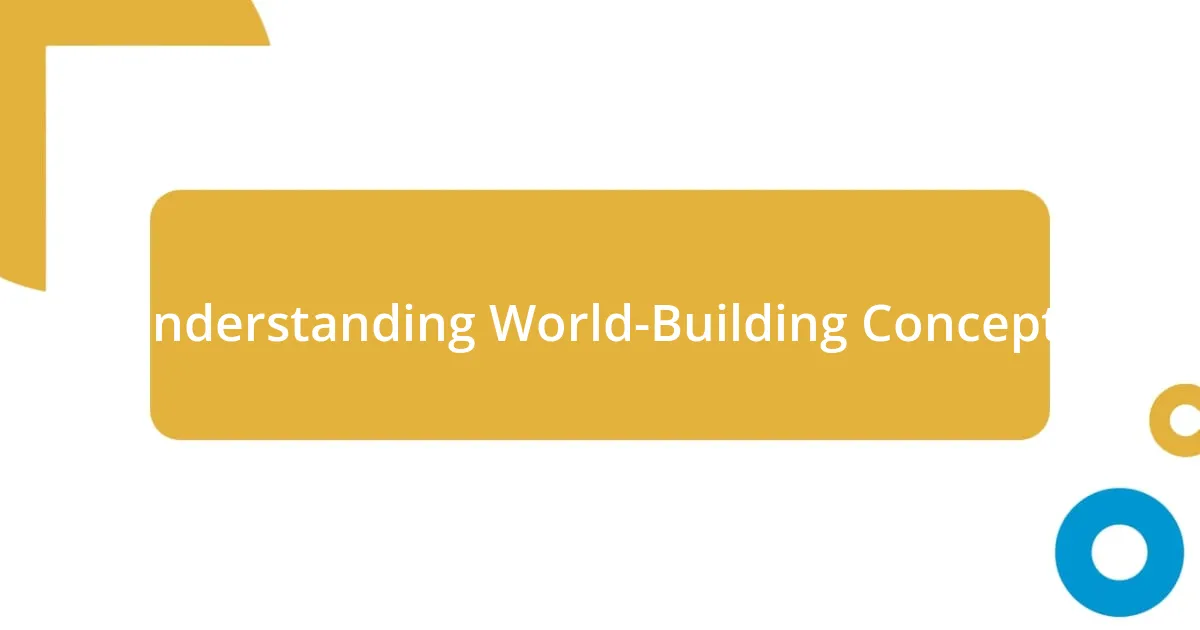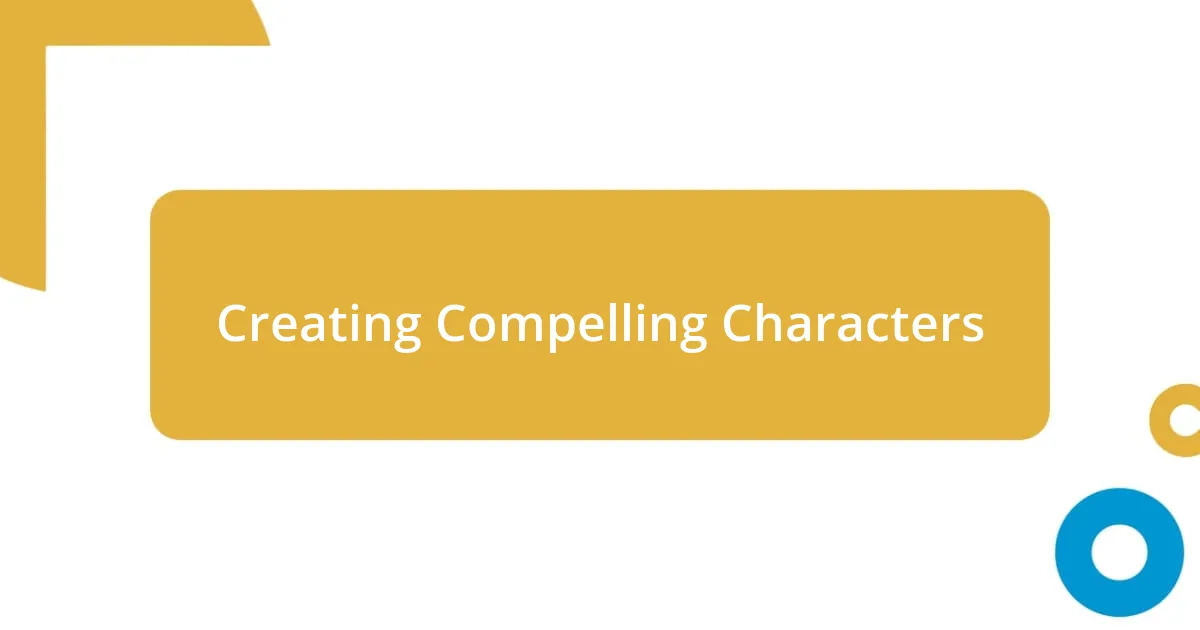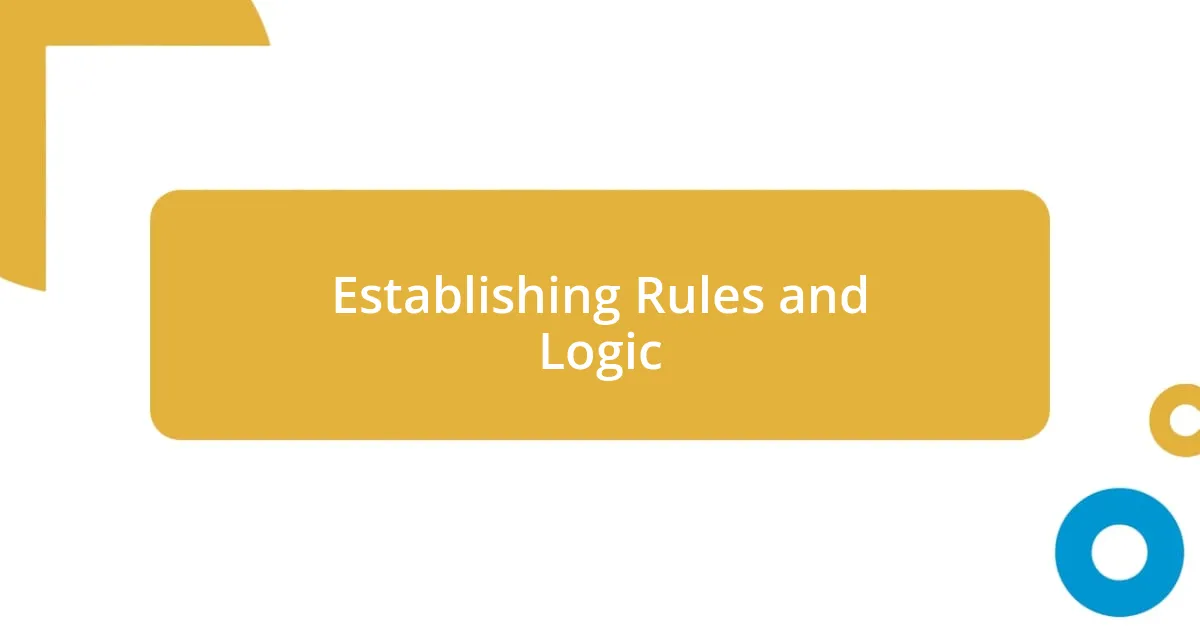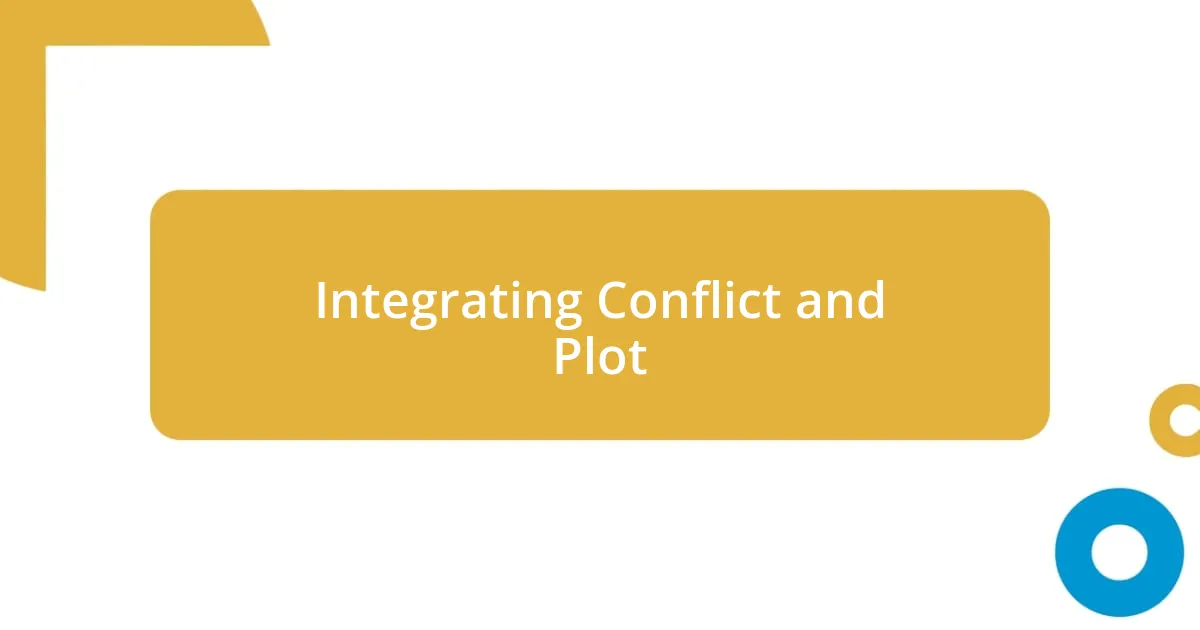Key takeaways:
- World-building requires coherence among all elements to maintain believability and enhance reader engagement.
- Defining the universe’s foundational aspects, like geography and societal structures, is crucial for logical consistency in the narrative.
- Creating relatable characters with complex motivations and dynamic arcs deepens emotional connections with the audience.
- Integrating evolving conflict into the plot keeps the story engaging and mirrors real-life unpredictability.

Understanding World-Building Concepts
World-building is not just about creating fantastical landscapes; it’s about crafting a universe with its own rules, cultures, and histories. I remember the thrill of sketching maps for my first fantasy novel, feeling like a god as I plotted rivers and mountains. Every detail added depth and made the world feel alive, but it also raised a question: how can one ensure the world remains believable within its own context?
When I began to understand the concepts behind world-building, I realized the importance of coherence. For instance, I once created a magical system that seemed clever at first but quickly fell apart because of its inconsistencies. Have you ever faced a similar issue in your own projects, where a brilliant idea crumbled under scrutiny? It’s a harsh lesson, but it taught me that every element of a world must relate to and support the others, ensuring a seamless experience for the reader.
Emotional stakes are another key aspect of world-building that I learned to appreciate. In one story, I embedded societal norms that resonated with my own experiences of belonging and exclusion. The characters’ struggles with these norms drew readers in, making them reflect on their own lives. Have you considered how your personal experiences can shape the worlds you create, inviting your audience to engage on a deeper level? Through this approach, the world becomes not just a backdrop but a vital component of the narrative.

Defining Your Story’s Universe
Defining your story’s universe is like laying the foundation of a house; it’s crucial for everything that follows. I recall a time when I meticulously crafted the geography of my fictional realm, only to realize later that my climate choices contradicted the flora and fauna I had invented. It’s a reminder that these foundational elements must align logically. If your world has a desert landscape, for instance, you wouldn’t expect to encounter thriving rainforests without some incredible reason.
Schemas and systems also play a pivotal role in creating a believable universe. When I built a society around a unique resource like a rare gemstone, I had to think critically about how it would affect trade, social hierarchy, and even conflicts. Have you ever considered how a single element in your world can ripple out and change everything? This connectedness fosters realism and depth, compelling readers to invest in not just the story, but also in the world itself.
Let’s not forget the emotional layer of your universe. In one of my projects, I intertwined the landscape with my characters’ emotions—stormy weather signified conflict, while serene sunsets marked moments of peace. This approach invites readers to feel the world rather than just observe it. It can be incredibly rewarding to use the universe to reflect your characters’ journeys in a way that resonates with your audience.
| Element | Importance |
|---|---|
| Geography | Shapes the logical flow of events and interactions. |
| Societal Structures | Influences the characters’ motivations and conflicts. |
| Emotional Landscapes | Enhances reader engagement by connecting emotions with the environment. |

Creating Compelling Characters
Creating compelling characters is essential to drawing readers into your world. I remember my excitement when I developed a character whose flaws mirrored my own uncertainties. This wasn’t just a creation for the sake of the plot; it became a way for me to explore my inner struggles. Characters that reflect genuine human experiences can resonate deeply with readers, making them feel as if they know these people in real life.
To make your characters truly compelling, consider these elements:
-
Complex Motivations: Characters should have desires that are not always clear-cut. A hero with a dark secret can add layers to their journey.
-
Dynamic Arcs: Change is essential. I had a character who began as selfish but learned the value of community, reflecting the growth we all experience.
-
Relatable Traits: Even in fantastical settings, traits like courage, fear, and love ground your characters, allowing readers to empathize with their struggles and triumphs.
Building on these concepts, I’ve found that the most memorable characters often come from moments of introspection or vulnerability. For example, when I crafted a character who grapples with fear of failure, I tapped into my own experiences facing challenges. This connection not only enriched my storytelling but also ensured the character’s journey felt authentic.

Establishing Rules and Logic
Establishing rules and logic in your world can feel a bit daunting, especially if you’re unsure where to start. I once found myself wrestling with the magic system in one of my stories. Initially, I made it far too powerful without considering the consequences. When I finally set clear boundaries around how magic could be used, it not only added tension but also crafted a more engaging narrative. Isn’t it fascinating how a single rule can untangle a complex plot?
I’ve found that consistency is key when it comes to rules. For instance, I created a society where technology and magic coexisted, but I needed to define how they interacted. I introduced a rule that magic couldn’t exceed a certain threshold during technological advances, which created obstacles for my characters. This balance not only preserved the stakes but also invited the reader to ponder: what happens when technology pushes the limits of magic?
The ability to adapt rules as your story evolves is essential, too. During a writing workshop, my mentor advised me to treat my world as a living entity that can change and grow. I took that advice to heart when unexpected plot twists altered my character’s capabilities, making it necessary to redefine specific magical laws. It taught me that flexibility within established logic not only keeps the narrative dynamic, but it also mirrors real-life complexities. How do we navigate changes in our own lives? That question helped deepen my connection with readers, reflecting the unpredictable journeys we all face.

Designing Interactive Settings
Designing interactive settings invites readers to immerse themselves in the world you’ve created and experience it, rather than just observe it. I remember crafting a sprawling cityscape where the weather changed in response to the characters’ emotions—sunshine when they were joyous and rain when they faced despair. This approach not only enhanced my narrative but also prompted readers to ponder how environment shapes our feelings. Have you ever noticed how a simple rainy day can affect your mood?
To truly engage your audience, consider incorporating sensory details that allow readers to feel as though they’re right there in the scene. I once described a marketplace bustling with vibrant colors, tantalizing aromas, and the sound of merchants shouting their wares. This level of detail helped my readers visualize the setting almost as if they could step into it. How much richer would your own worlds become if they were painted in vivid experiences?
Interactive settings can also evolve based on reader choices or character actions, creating a sense of agency. I experimented with this by allowing a character’s decisions to change the outcome of a crucial event, effectively altering the course of the narrative. The feedback I received from my readers was overwhelming; they felt like co-creators of the story. I bet you’ve had moments in your own life where a single choice dramatically shifted your path. Wouldn’t it be fascinating to mirror that sense of agency in our storytelling?

Integrating Conflict and Plot
Integrating conflict into your plot is crucial for creating a gripping narrative that keeps readers engaged. I once found myself writing a story with a protagonist who faced a seemingly insurmountable challenge: bridging two rival factions. By introducing a personal connection—she was torn between her best friend from one faction and the love of her life from the other—conflict naturally emerged. This internal struggle amplified the external tensions, resulting in a story that resonated emotionally. Have you ever felt torn between two loyalties? That’s the heart of compelling conflict.
Every twist and turn in your plot should resonate with the conflict at hand. In another project, I added a ticking clock element, where my character had to find a way to unite the factions before a devastating war erupted. The countdown created urgency, pushing the plot forward and forcing my character to confront not only external enemies but also her own fears and doubts. Isn’t it intriguing how time can manipulate our decisions and outcomes? Crafting such layers of conflict enriches the narrative fabric.
Finally, I believe that conflict should evolve as the plot unfolds, challenging characters in unexpected ways. I learned this firsthand when a minor character I introduced turned out to be a critical antagonist, thwarting my protagonist’s efforts against her own desires. This twist not only intensified the stakes, but it also forced me to rethink the entire trajectory of the plot. How often do we encounter unforeseen challenges in our own lives that require a shift in our approach? This reflection deepened the authenticity of my story, creating a narrative that feels as dynamic and unpredictable as life itself.

Iterating and Evolving Your World
Iterating and evolving your world is a vital part of the world-building process that shouldn’t be overlooked. I remember when I first created a magical forest with whimsical creatures and hidden dangers. Over time, I realized that the more I fleshed out the history and the rules governing that forest—like why certain trees swayed in harmony with the wind—the more alive and relatable my setting felt to readers. Have you ever noticed how even small tweaks in a story can lead to a more immersive experience?
As I continued to develop this world, I found feedback from readers to be a goldmine of insight. In one instance, a reader pointed out how much they enjoyed the idea of a creature that could only be seen during a specific lunar phase. This inspired me to revise and deepen that lore, adding layers of intrigue and mystery. Can you imagine how enriching it is when your audience contributes to the evolution of your world? It’s a delightful loop of creativity!
Growth often means embracing change, and I learned this through my process of incorporating character backstories into the world’s narrative. Originally, my characters were stand-alone figures, but as I connected their histories to the culture and geography of my world, the entire setting came alive. I once had a character whose island origin was tied to a volcanic eruption, and this became a pivotal theme in the story. Don’t you think that connecting characters to their environments creates a more cohesive and engaging narrative? It’s fascinating how intertwining a character’s journey with the world’s history can elevate the stakes and deepen emotional resonance.














